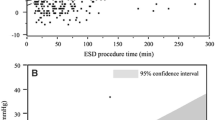Abstract
Background
Insufflation with carbon dioxide (CO2) in colonoscopy has not been widely adopted and, consequently, limited data are available on insufflated gas volume and blood pCO2. The aim of this study was to compare CO2 and air as an insufflation agent in patients undergoing colonoscopy without sedation in terms of insufflated gas volume, pCO2, pain and examination time.
Methods
This was a randomized, double-blind, control trial. Consecutive patients presenting for colonoscopy, excluding those with lung or malignant disease, were randomized into two groups: insufflation with air or with CO2, respectively. Insufflated gas volume, pain, pCO2 and examination time were assessed.
Results
The study cohort comprised 120 patients (66 randomized to CO2 group). No significant difference in insufflated gas volumes was found between the CO2 and air groups. The mean pCO2 measured before, during (the peak value) and 30 min after colonoscopy were 40, 43 and 40 mmHg, respectively, in both groups. The pain scores in the air group were significantly greater than those in the CO2 group until 3 h after the examination. There was a significant faster cecal intubation time and a trend toward shorter examination time in the CO2 group.
Conclusions
The CO2 gas volume used in our study (14.0 L) was much greater than that reported by others (8.3 L), but the pCO2 values were still within the normal reference range, indicating the safety of CO2 insufflation over a greater range of CO2 gas volume. Among our patients, CO2 insufflation was associated with relatively less pain and a shorter examination time. Based on our results, we recommend that CO2 become the standard gas for insufflation in patients undergoing colonoscopy without sedation.



Similar content being viewed by others
References
Stevenson GW, Wilson JA, Wilkinson J, Norman G, Goodacre RL. Pain following colonoscopy: elimination with carbon dioxide. Gastrointest Endosc. 1992;38:564–7.
Sumanac K, Zealley I, Fox BM, Rawlinson J, Salena B, Marshall JK, et al. Minimizing postcolonoscopy abdominal pain by using CO(2) insufflation: a prospective, randomized, double blind, controlled trial evaluating a new commercially available CO(2) delivery system. Gastrointest Endosc. 2002;56:190–4.
Bretthauer M, Thiis-Evensen E, Huppertz-Hauss G, Gisselsson L, Grotmol T, Skovlund E, et al. NORCCAP (Norwegian colorectal cancer prevention): a randomised trial to assess the safety and efficacy of carbon dioxide versus air insufflation in colonoscopy. Gut. 2002;50:604–7.
Church J, Delaney C. Randomized, controlled trial of carbon dioxide insufflation during colonoscopy. Dis Colon Rectum. 2003;46:322–6.
Wong JC, Yau KK, Cheung HY, Wong DC, Chung CC, Li MK. Towards painless colonoscopy: a randomized controlled trial on carbon dioxide-insufflating colonoscopy. ANZ J Surg. 2008;8:871–4.
Bretthauer M, Lynge AB, Thiis-Evensen E, Hoff G, Fausa O, Aabakken L. Carbon dioxide insufflation in colonoscopy: safe and effective in sedated patients. Endoscopy. 2005;37:706–9.
Dellon ES, Hawk JS, Grimm IS, Shaheen NJ. The use of carbon dioxide for insufflation during GI endoscopy: a systematic review. Gastrointest Endosc. 2009;69:843–9.
Bretthauer M, Hoff GS, Thiis-Evensen E, Huppertz-Hauss G, Skovlund E. Air and carbon dioxide volumes insufflated during colonoscopy. Gastrointest Endosc. 2003;58:203–6.
Janssens F, Deviere J, Eisendrath P, Dumonceau JM. Carbon dioxide for gut distension during digestive endoscopy: technique and practice survey. World J Gastroenterol. 2009;28:1475–9.
Erchinger F, Dimcevski G, Gilja OH, Hausken T. Abdominal ultrasound after colonoscopy with insufflation of carbon dioxide versus air. Scand J Gastroenterol. 2009;44:1055–9.
Acknowledgments
We express our thanks to Ms. Tokiko Itou for her secretarial assistance.
Author information
Authors and Affiliations
Corresponding author
Rights and permissions
About this article
Cite this article
Yamano, Ho., Yoshikawa, K., Kimura, T. et al. Carbon dioxide insufflation for colonoscopy: evaluation of gas volume, abdominal pain, examination time and transcutaneous partial CO2 pressure. J Gastroenterol 45, 1235–1240 (2010). https://doi.org/10.1007/s00535-010-0286-5
Received:
Accepted:
Published:
Issue Date:
DOI: https://doi.org/10.1007/s00535-010-0286-5




